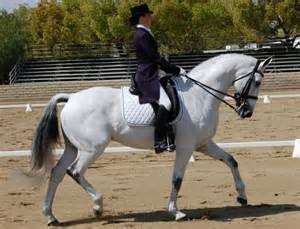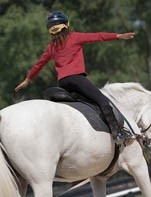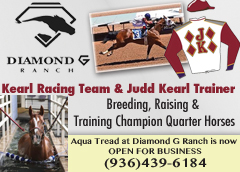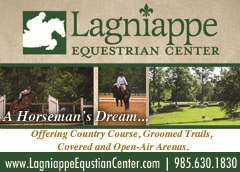Written by Barbara Newtown
Original Publish Date August 2014
Dr. Sandra Marx, DC (Doctor of Chiropractic), of Crowley, Louisiana, is a retired Technical Delegate for the United States Equestrian Federation and a large “R” dressage judge. She has been the instructor, trainer, and owner of Shadowfax Dressage Farm in Metairie. At present she teaches dressage at the Oak Haven Equestrian Center in Rayne.
 Mastering dressage takes a lifetime, both for people and for horses. The discipline has a difficult vocabulary all its own. Experts use phrases like “descente de main” and “Durchlaessigkeit” which can’t be translated clearly into English. The movements, like passage, piaffe, and flying changes every stride, seem impossible to the average pleasure rider and pleasure horse. Yet “dressage” simply means “training.” The aim of dressage is to make a horse obedient, responsive, and sound for a long life of being ridden. Any horse will improve with basic dressage exercises. Any rider will, too: who doesn’t want to be balanced, effective, and kind on horseback?
Mastering dressage takes a lifetime, both for people and for horses. The discipline has a difficult vocabulary all its own. Experts use phrases like “descente de main” and “Durchlaessigkeit” which can’t be translated clearly into English. The movements, like passage, piaffe, and flying changes every stride, seem impossible to the average pleasure rider and pleasure horse. Yet “dressage” simply means “training.” The aim of dressage is to make a horse obedient, responsive, and sound for a long life of being ridden. Any horse will improve with basic dressage exercises. Any rider will, too: who doesn’t want to be balanced, effective, and kind on horseback?
So give a local dressage teacher a call. Dr. Marx has advice for choosing the right one: “Ask for the instructor’s qualifications. Who have they trained with? Where have they shown? What are their skill sets?” Observe some lessons. Ask yourself: do I like this person’s teaching style? Can I work with this instructor, and can this instructor work with me? Can this instructor work with my horse? Does the instructor have school horses? Visit with the other students. Ask the instructor for references. And be honest with yourself: are you taking lessons because you have wild dreams of going to the Olympics…or because you want to proclaim “I’m a dressage rider!”? The best reason for starting dressage lessons is that you want better communication with your horse. The payoff is that your horse will trust you and listen to you. Dressage makes a rider quiet, sensitive, and, above all, fair.
Dr. Marx explains that there are several methods for training horses and riders in dressage, but the basic need is having a horse, either your own or the teacher’s schoolmaster, that is calm and dependable and can teach a rider how to start, stop, and steer. When riders come for their first lesson, Dr. Marx evaluates their body type, riding experience, show experience, and ability to balance.
“I like to start all of my students on the lunge line,” she says. In a lunging lesson, the instructor stands in the middle of a large circle and controls the horse with a line attached to a cavesson or to the bridle’s bit. The instructor holds a long whip in the other hand, and asks the trained horse to make a larger circle or move more forward by pointing the whip at the horse’s shoulders or hindquarters. The student doesn’t touch the reins and concentrates instead on position and balance.
“I was trained by Vanessa Vaile, a wonderful lunging teacher, and my skills developed fast. I learned to walk, trot, and canter without stirrups and without reins,” says Dr. Marx. “Riding on the lunge teaches a student not to use the stirrups and reins as balancing tools.” An “independent seat” is the goal of a dressage rider.
“Before I ask a student to get on a horse, I introduce the lunging exercises on a lunging barrel. They learn how to mount and dismount, lean forward, lean back, and swing their legs. I have started riders this way as young as four, and as old as sixty-five.” Dr. Marx lets them practice taking up and letting go of the reins, and she teaches them to go “around the world”—turn around on the barrel clockwise and counter-clockwise. The barrel, unlike a horse, is endlessly patient.
“Then they get on a school horse and do the same gymnastics at a standstill. Then they learn to do them—including ‘around the world’—at the walk, the trot, and eventually the canter.” Dr. Marx adds even more exercises: reaching straight up, reaching out to the sides, flexing the ankles, holding legs away from the horse’s body, and, of course, posting the trot. The student learns to fine-tune the rhythm and timing of the posting. To teach her students to think and ride at the same time, Dr. Marx asks them to name the different parts of the horse while they’re trying to maintain their balance.
Dr. Marx bases her instruction on the principles of classical dressage. She has studied with Charles de Kunffy, Fran Dearing, Egon von Neindorff, and many others. “Train with a variety of instructors,” she says. “Take what is useful and bring it back to your own table.”
If all goes well, you will be able to balance without grabbing the reins. Your horse will thank you!





